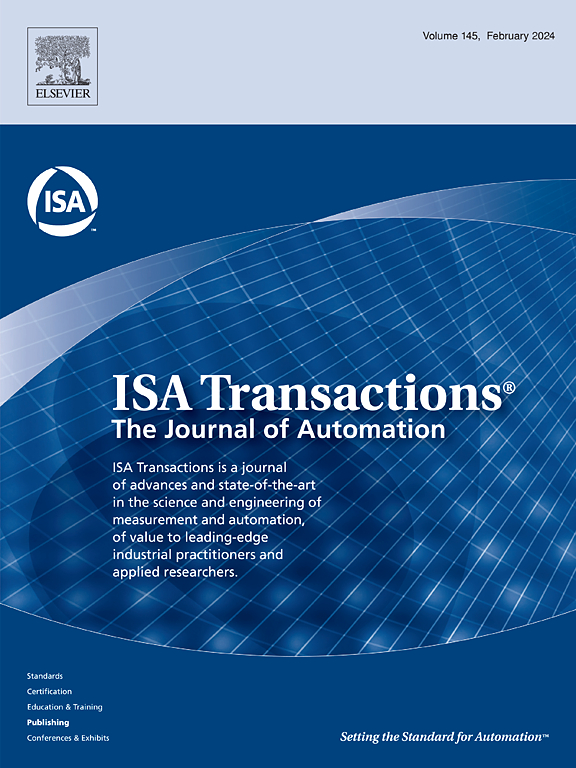Periodic event-triggered robust trajectory tracking control for underactuated unmanned surface vehicle without velocity measurement
IF 6.5
2区 计算机科学
Q1 AUTOMATION & CONTROL SYSTEMS
引用次数: 0
Abstract
This paper proposes a periodic event-triggered control (PETC) algorithm for underactuated unmanned surface vehicle (USV) subject to unknown exogenous perturbances within limited communication bandwidth. Initially, the underactuated USV model is reformulated using output redefinition-based dynamic inversion (ORDI) so that the system attains a well-defined relative degree through an approximate variable vector. While typical USV control strategies isolate the yaw and surge channel, the ORDI integrates both dimensions into a single framework to adopt a direct controller design. Subsequently, the minimum-learning-parameter radial basis function neural network (RBFNN) with adaptive laws is employed to effectively approximate the nonlinear dynamics and external perturbations with rapid and fewer computations. After that, an anti-chattering velocity observer is presented to provide accurate velocity estimation based solely on position data transmission. Building on this, a PETC algorithm is introduced which balances the periodic sampling with traditional event-triggered control via a sliding mode manifold. This mechanism is designed to assess the requirement for computations and the subsequent transmission of updated measurements alongside current control signals. Furthermore, it can dynamically adjust the communication frequency between the controller and the actuators, in accordance with the digital platform’s demands. Moreover, Theoretical analysis rigorously proves that state errors and estimation errors converge to equilibrium and ensure the system stability. Numerical simulations substantiate the robustness and superior performance of the proposed control scheme under bandwidth limitations and uncertain conditions.
欠驱动无人水面车辆无速度测量的周期事件触发鲁棒轨迹跟踪控制。
针对欠驱动无人水面飞行器(USV)在有限通信带宽下受到未知外源扰动的情况,提出了一种周期事件触发控制(PETC)算法。首先,使用基于输出重新定义的动态反演(ORDI)重新制定欠驱动USV模型,以便系统通过近似变量向量获得定义良好的相对程度。虽然典型的USV控制策略隔离了偏航和浪涌通道,但ORDI将这两个维度集成到单个框架中,采用直接控制器设计。随后,采用具有自适应律的最小学习参数径向基函数神经网络(RBFNN),快速、少计算地有效逼近非线性动力学和外部扰动。然后,提出了一种抗抖速度观测器,仅基于位置数据传输提供准确的速度估计。在此基础上,介绍了一种PETC算法,该算法通过滑模流形来平衡周期性采样和传统的事件触发控制。该机制旨在评估对计算的要求以及随后与当前控制信号一起更新测量的传输。此外,它还可以根据数字平台的要求动态调整控制器与执行器之间的通信频率。理论分析证明了状态误差和估计误差收敛于平衡态,保证了系统的稳定性。数值仿真验证了该控制方案在带宽限制和不确定条件下的鲁棒性和优越的性能。
本文章由计算机程序翻译,如有差异,请以英文原文为准。
求助全文
约1分钟内获得全文
求助全文
来源期刊

ISA transactions
工程技术-工程:综合
CiteScore
11.70
自引率
12.30%
发文量
824
审稿时长
4.4 months
期刊介绍:
ISA Transactions serves as a platform for showcasing advancements in measurement and automation, catering to both industrial practitioners and applied researchers. It covers a wide array of topics within measurement, including sensors, signal processing, data analysis, and fault detection, supported by techniques such as artificial intelligence and communication systems. Automation topics encompass control strategies, modelling, system reliability, and maintenance, alongside optimization and human-machine interaction. The journal targets research and development professionals in control systems, process instrumentation, and automation from academia and industry.
 求助内容:
求助内容: 应助结果提醒方式:
应助结果提醒方式:


